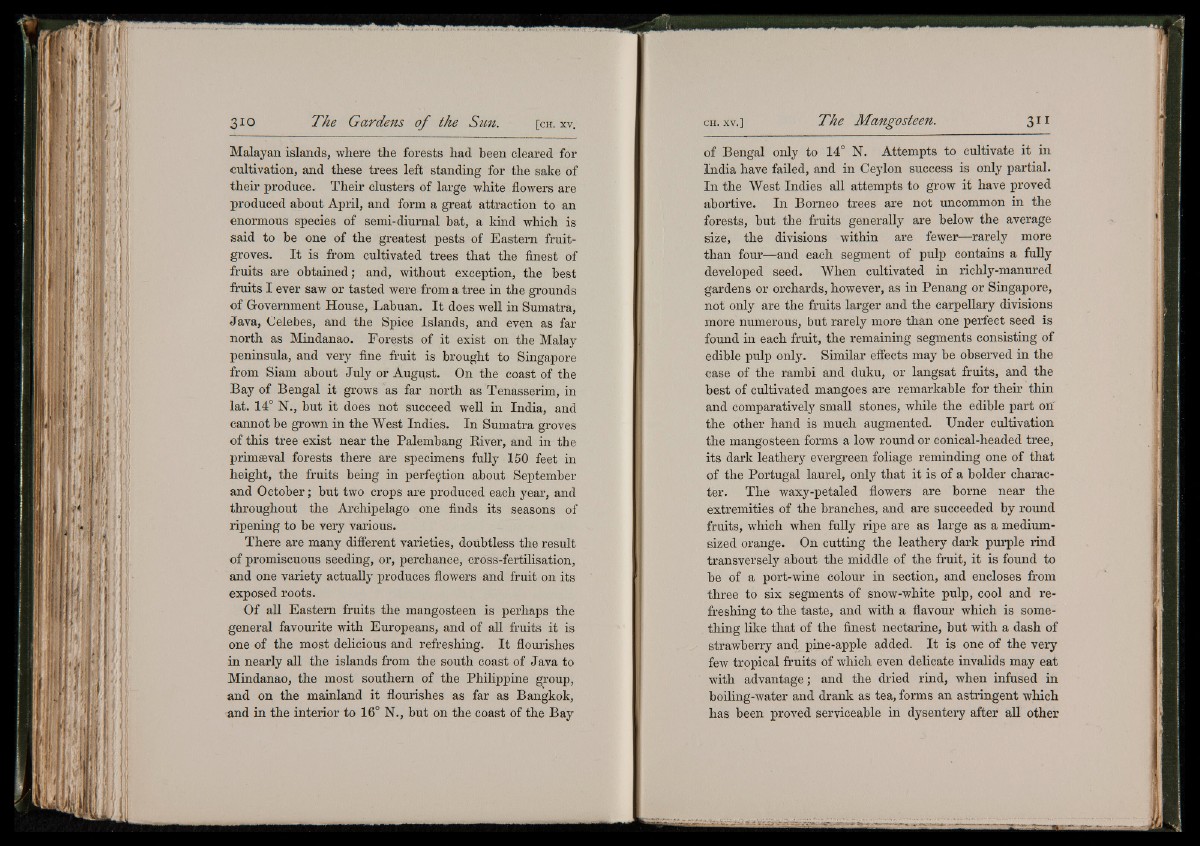
Malayan islands, where the forests had been cleared for
cultivation, and these trees left standing for the sake of
their produce. Their clusters of large white flowers are
produced about April, and form a great attraction to an
enormous species of semi-diurnal bat, a kind which is
said to he one of the greatest pests of Eastern fruit-
groves. It is from cultivated trees that the finest of
fruits are obtained; and, without exception, the best
fruits I ever saw or tasted were from a tree in the grounds
of Government House, Labuan. It does well in Sumatra,
Java, Celebes, and the Spice Islands, and even as far
north as Mindanao. Forests of it exist on the Malay
peninsula, and very fine fruit is brought to Singapore
from Siam about July or August. On the coast of the
Bay of Bengal it grows as far north as Tenasserim, in
lat. 14° N., hut it does not succeed well in India, and
cannot be grown in the West Indies. In Sumatra groves
of this tree exist near the Palembang Biver, and in the
primaeval forests there are specimens fully 150 feet in
height, the fruits being in perfe§tion about September
and October; but two crops are produced each year, and
throughout the Archipelago one finds its seasons of
ripening to be very various.
There are many different varieties, doubtless the result
of promiscuous seeding, or, perchance, cross-fertilisation,
and one variety actually produces flowers and fruit on its
exposed roots.
Of all Eastern fruits the mangosteen is perhaps the
general favourite with Europeans, and of all fruits it is
one of the most delicious and refreshing. It flourishes
in nearly all the islands from the south coast of Java to
Mindanao, the most southern of the Philippine group,
and on the mainland it flourishes as far as Bangkok,
and in the interior to 16° N., but on the coast of the Bay
of Bengal only to 14° N. Attempts to cultivate it in
India have failed, and in Ceylon success is only partial.
In the West Indies all attempts to grow it have proved
abortive. In Borneo trees are not uncommon in the
forests, but the fruits generally are below the average
size, the divisions within are fewer—rarely more
than four—and each segment of pulp contains a fully
developed seed. When cultivated in richly-manured
gardens or orchards, however, as in Penang or Singapore,
not only are the fruits larger and the carpellary divisions
more numerous, but rarely more than one perfect seed is
found in each fruit, the remaining segments consisting of
edible pulp only. Similar effects may be observed in the
case of the rambi and duku, or langsat fruits, and the
best of cultivated mangoes are remarkable for their thin
and comparatively small stones, while the edible part on
the other hand is much augmented. Under cultivation
the mangosteen forms a low round or conical-headed tree,
its dark leathery evergreen foliage reminding one of that
of the Portugal laurel, only that it is of a bolder character.
The waxy-petaled flowers are borne near the
extremities of the branches, and are succeeded by round
fruits, which when fully ripe are as large as a mediumsized
orange. On cutting the leathery dark purple rind
transversely about the middle of the fruit, it is found to
be of a port-wine colour in section, and encloses from
three to six segments of snow-white pulp, cool and refreshing
to the taste, and with a flavour which is something
like that of the finest nectarine, but with a dash of
strawberry and pine-apple added. It is one of the very
few tropical fruits of which even delicate invalids may eat
with advantage; and the dried rind, when infused in
boiling-water and drank as tea, forms an astringent which
has been proved serviceable in dysentery after all other